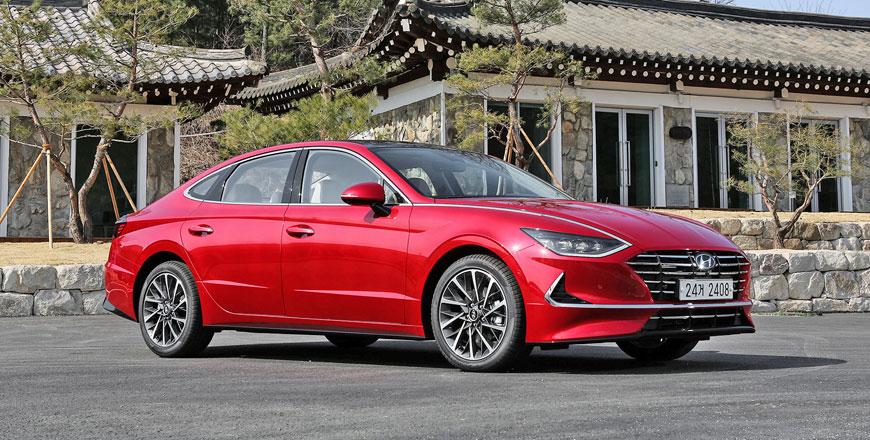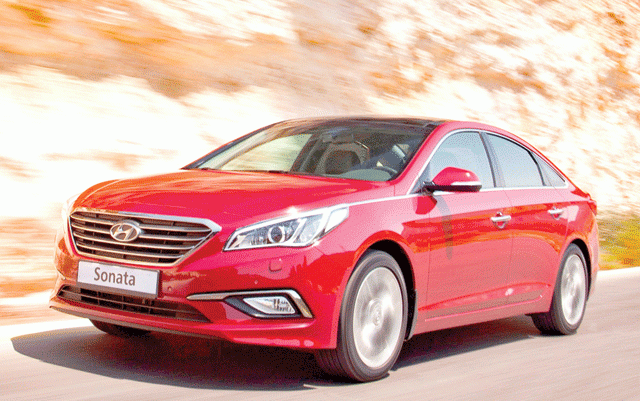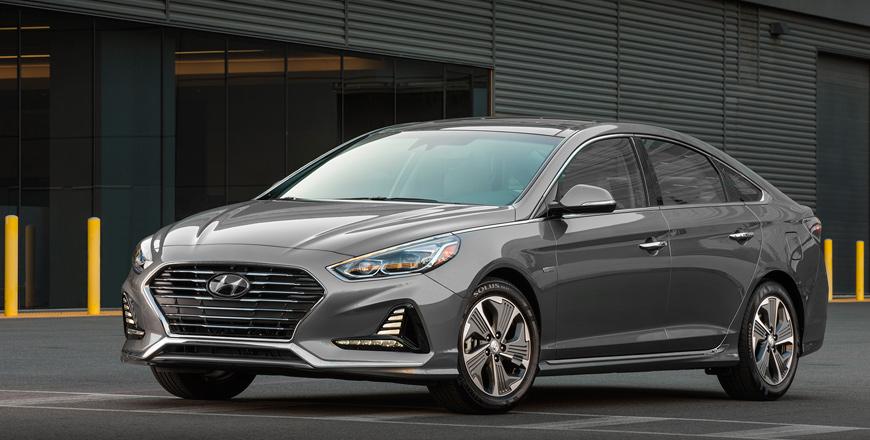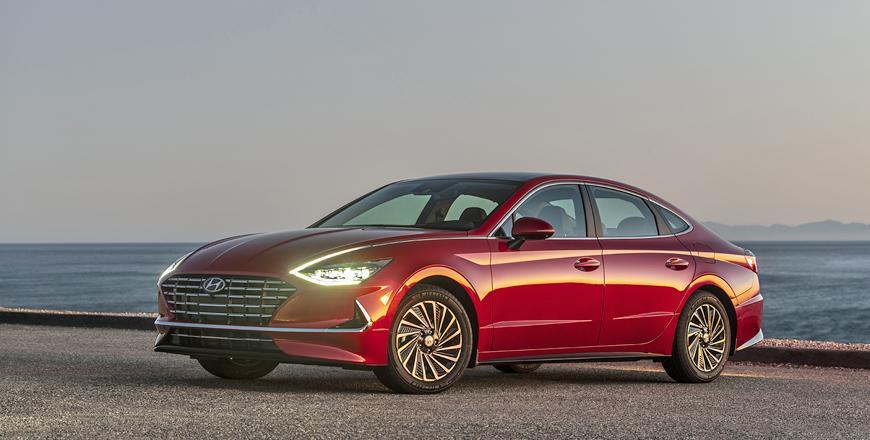You are here
Hyundai Sonata 2.5 MPI: Korean barracuda-like sense
By Ghaith Madadha - Aug 26,2019 - Last updated at Aug 26,2019

Photos courtesy of Hyundai
A far more dramatic and stylised car than the somewhat conservative model it replaces, the new eight generation Hyundai Sonata takes a distinctly sportier and edgier design direction.
Launched early this summer as a 2020 model and part the Korean brand’s more loosely and individualistic “Hyundai look” approach, the latest Sonata harks back to the eye-catching if somewhat controversial sixth generation model in the way it makes a statement.
However, the new Sonata backs this up with subtly yet meaningfully improved driving dynamics, new technologies and improved cabin design, comfort and materials.
Dramatic design
A design-led car very much informed by trendy so-called “four-door coupe” designs like the Audi A7, Mercedes-Benz CLS-Class and Volkswagen Arteon, Hyundai’s stated and ambitious goal for the new Sonata is to produce “the most beautiful sedan on the road”.
Whether they have achieved this is a matter of personal taste, but it is indeed an attractive, low-slung and viscerally dramatic design. Longer, lower and wider than its predecessor, the new Sonata is built on a new platform with repositioned front strut towers for a lower bonnet, shorter front overhang and longer wheelbase.
A front-driven car with a similarly sporty profile as an upmarket rear-drive saloon in its overhang ratios and distance between wheel centre and A-pillar base, the new Sonata seemingly taking inspiration from marine life. At first sight it somewhat resembles a stingray, with its broad shoulders, wide stance, sharply creased lined and heavily ridged surfacing.
However, its wide, almost frowning “cascading grille” design, protruding lower lip, prominent sills and long low and arcing — almost fastback — roofline and discrete rear light cluster fins instead lend it an almost barracuda-like sense of menace and drama.
Confident delivery
Available at launch with either 2- and 2.5-litre naturally-aspirated multipoint injection (MPI) engines mated to 6-speed automatic gearboxes for the Middle East, other Sonata versions available or expected for various markets include 8-speed gearboxes, and all four-cylinder direct injection, hybrid and more performance-oriented turbocharged “N” sub-brand variants.
Driven in 2.5-litre MPI guise and with similar output as its 2.4-litre predecessor, the Sonata develops 177BHP at 6,000rpm and 171lb/ft torque at 4,000rpm. Undisclosed, the Sonata’s estimated 1.5-tonnes or less weight is expected to be reasonably quick with around 9.5-second 0-100km/h acceleration and 210km/h top speed.
Responsive from standstill and smoothly progressive in delivery, the driven 2.5 MPI proved well suited to the Sonata’s size, segment and weight as driven in various routes in South Korea at launch. Well-refined and insulated, it pulled with confident versatility in mid-range and when cruising, while venturing towards the redline, it was willing and eager.
Driving the front wheels through a standard 6-speed automatic gearbox, shifts had the right compromise between speed, response and smoothness for a medium to big comfortable family saloon, and feature push-button gear selection and manual mode steering-mounted paddle-shifters.
Dynamic improvements
Built on Hyundai’s new N3 platform with improved structural design for improved ride, handling and safety, and incorporating more sophisticated collision safety multiload paths, the new Sonata better reconciles its assertively sporty looks with improved dynamic capabilities.
Stable and reassuring on highway and smooth and refined in its ride quality, the new Sonata is comfortable and well absorbs road imperfections, but can feel slightly firm over small jagged bumps, as driven with 235/45R18 optional low profile tyres. Through corners, lateral and roll control is improved and it feels more settled than before.
Similarly, it seems to have acquired firmer dampers and improved vertical body and rebound control on dips and crests, and feels more settled and buttoned down than its predecessor.
Turning tidily into corners with light, quick and direct electric-assisted steering, the Sonata grips well front and rear, but is weighted with a slight bias for more predictable under-steer if entering a tight and narrow too aggressively, which can be controlled through its electronic stability controls or by easing slightly off the throttle. Meanwhile, a larger brake booster improves braking response and effectiveness.
Comfortably equipped
A significant improvement on the outgoing model in most respects, the new Sonata also receives a plusher and more pleasant interior, in addition to more advanced convenience and safety equipment.
Said by Hyundai to be inspired by stealth aircraft the low-slung new Sonata’s cabin features a cleaner, less cluttered design with an emphasis on horizontal lines and creating a sense of width and space.
This includes a narrower dash, unobstructive push-button shift-by-wire gear selector and a reduced button count, with most features accessed through a large and wide 12.3-inch touchscreen.
Classier looking and incorporating better materials and softer textures and touch points, the new Sonata is also well-equipped and includes numerous standard and optional features including Android Auto, text-to-speech Bluetooth, heated and ventilated seats and wireless phone charging.
It also has driver assistance features like lane keeping and following, blind spot, forward and rear cross-traffic collision avoidance assists and more.
Comfortable inside, it also features good cabin width, legroom and generous luggage volume. However, given its rakish new roofline, the Sonata could have done with slightly lower seat mounting points for taller occupants, especially in sunroof-equipped models.
TECHNICAL SPECIFICATIONS
- Engine: 2.5-litre, aluminium block/head, transverse 4-cylinders
- Bore x stroke: 88.5 x 101.5mm
- Valve-train: DOHC, 16-valve, continuously variable valve timing
- Gearbox: 6-speed automatic, front-wheel-drive
- Power, BHP (PS) [kW]: 177.5 (180) [132.4] @6,000rpm
- Specific power: 71BHP/litre
- Torque, lb/ft (Nm): 171 (232) @4,000rpm
- Specific torque: 92.9Nm/litre
- 0-100km/h: 9.5-seconds (est.)
- Top speed: 210km/h (est.)
- Length: 4,900mm
- Width: 1,859mm
- Height: 1,445mm
- Wheelbase: 2,840mm
- Headroom, F/R: 975/950mm
- Leg room, F/R: 1,171/884mm
- Shoulder room, F/R: 1,470/1,425mm
- Hip room, F/R: 1,386/1,381mm
- Doors/seats: 4/5
- Luggage volume: 453-litres
- Kerb weight: 1,450-1,500kg (est.)
- Steering: Electric-assisted rack and pinion
- Lock-to-lock: 2.6-turns
- Turning circle: 10.9-metres
- Suspension, F/R: MacPherson struts/multi-link
- Brakes F/R: Ventilated discs, 305mm/discs, 300mm
- Tyres: 235/45R18
Related Articles
A follow-up to Hyundai’s radically styled sixth generation Sonata circa 2010, the new 2015 model year seventh generation is an evolutionary but thoroughly redesigned, made-over new model with significant engineering improvements.
By Ghaith Madadha Among Jordan’s most popular mid-size saloons, the Hyundai Sonata Hybrid is a comfortable, smooth and refined cruiser
An assertively stylised and dramatic design departure from its conservative predecessor, the eight Hyundai Sonata instead harks back to the














